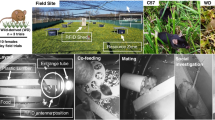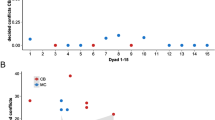Summary
The social behavior of house mice captured from natural populations was studied in an enclosure. Six replicate experiments with observations totalling 344 h were done to contrast the behavior of outbreeders, individuals that have progeny by interdemic reproduction; inbreeders, individuals that have progeny by intrademic reproduction; and nonbreeders. The frequency of outbreeding was also determined.
In each replicate, two male and three female commensal house mice, Mus musculus, homozygous for the same allele at the hemoglobin locus, Hbbs, were put in half of a population cage. A barrier separated this deme from another deme homozygous for the alternative allele, Hbbd. The barrier was removed after a month and each experiment continued for a further two months with daily observations.
In five of six experiments, the mice from both demes formed one social group and in the sixth experiment, the mice remained in their original demes. In two experiments, outbreeding occurred: females from one deme produced offspring by males from the other deme. In three experiments, inbreeding occurred: females produced offspring by males from the same deme. Soon after the demes had formed one social group in these three experiments, the remaining male in a deme was killed and the experiment terminated; females without a male readily join other demes. The pattern of breeding resulted in a genetically effective size, N e , that was approximately half of the maximum N e obtainable with random mating. The social organization of house mice, although structured and characterized by male territoriality, presents no major barrier to gene flow within populations.
Affiliative (mount, allogroom, follow) and agonistic (fight, chase, attack) behavior occurring when the barrier was present had no predictive value in determining which mice would be outbreeders. With the barrier absent, outbreeders were the recipients of more affiliative behavior than inbreeders. Male outbreeders initiated more agonistic behavior than inbreeders. Outbreeders engaged in more interdemic affiliative behavior than inbreeders.
Similar content being viewed by others
References
Adamczyk K, Ryszkowski L (1965) Settling of mice (Mus musculus L.) released in an uninhabited and inhabited place. Bull Acad Pol Sci 13:631–637
Anderson PK (1970) Ecological structure and gene flow in small mammals. Symp Zool Soc London 26:299–325
Andrzjewski R, Petrusewicz K, Walkowa W (1963) Absorption of newcomers by a population of white mice. Ekol Pol A 11:223–240
Baker AEM (1981) Gene flow in house mice: Introduction of a new allele into free-living populations. Evolution (in press)
Barnett SA, Smart JL (1975) The movements of wild and domestic house mice in an artificial environment. Behav Biol 15:85–93
Berry RJ (1978) Genetic variation in wild house mice: where natural selection and history meet. Am Sci 66:52–60
Berry RJ, Jakobson ME (1974) Vagility in an island population of the house mouse. J Zool London 173:341–354
Bronson FH (1979) The reproductive ecology of the house mouse. Q Rev Biol 54:265–299
Brown RZ (1953) Social behavior, reproduction, and population changes in the house mouse (Mus musculus L.). Ecol Monogr 23:217–240
Butler RG (1980) Population number, social behavior, and dispersal in house mice: A quantitative investigation. Anim Behav 28:78–85
Crowcroft P (1966) mice all over. London, Foulis, pp 121
Crowcroft P, Rowe FP (1963) Social organization and territorial behaviour in the wild house mouse (Mus musculus L.). Proc Zool Soc London 140:517–531
DeFries JC, McClearn GE (1972) Behavioral genetics and the fine structure of mouse populations: A study in microevolution. In: Dobhzhansky T, Hecht MK, Stere WC (eds) Evolutionary biology, vol 5. Appleton-Century-Crofts New York, pp 279–291
DeLong KT (1967) Population ecology of feral house mice. Ecology 48:611–634
German AL, Khokhlova IS (1974) The dynamics of the hierarchial relations in experimental groups of laboratory Mus musculus L. (Rodentia). First Int Theriol Congr 1:187
Gilder PM, Slater PJB (1978) Interest of mice in conspecific male odours is influenced by degree of kinship. Nature 274:364–365
Hadow HH (1972) Freeze-branding: a permanent marking technique for pigmented mammals. J Wildl Manage 36:645–649
Justice KE (1962) Ecological and genetical studies of evolutionary forces acting on desert populations of Mus musculus. Report, Environ Sci Branch Div Biol and Med, US At En Comm, Arizona-Sonora Desert Museum, pp 68
Kirby G (1974) Ph D thesis, University of Adelaide
Klein J (1974) Genetic polymorphism of the histocompatability-2 loci of the mouse. Annu Rev Genet 8:63–77
Kuse AR, DeFries JC (1976) Social dominance and Darwinian fitness in laboratory mice: An alternative test. Behav Biol 16:113–117
Lidicker WZ (1976) Social behaviour and density regulation in house mice living in large enclosures. J Anim Ecol 45:677–698
Lloyd JA (1975) Social structure and reproduction in two freely-grwong populations of house mice (Mus musculus L.). Anim Behav 23:413–424
MacArthur RH, Wilson EO (1967) The theory of island biogeography. Princeton University Press, Princeton, NJ
Myers JH (1974) Genetic and social structure of feral house mouse population on Grizzly Island, California. Ecology 55:747–759
Newsome AE (1969) A population study of house mice permanently inhabiting a reed-bed in South Australia. J Anim Ecol 38:361–377
Oakeshott JC (1974) Social dominance, aggressiveness, and mating success among male house mice. Oecologia 15:143–158
Petrusewicz K, Andrzejewski R (1962) Natural history of a freeliving population of house mice (Mus musculus Linnaeus), with particular reference to groupings within the population. Ekol Pol A 10:85–122
Poole TB, Morgan HDR (1973) Differences in aggressive behaviour between male mice (Mus musculus L.) in colonies of different sizes. Anim Behav 21:788–795
Poole TB, Morgan HDR (1976) Social and territorial behaviour of laboratory mice (Mus musculus L.) in small complex areas. Anim Behav 24:470–480
Price EO (1978) Genotype versus experience effects on aggression in wild and domestic Norway rats. Behaviour 64:340–353
Reimer JD, Petras ML (1967) Breeding structure of the house mouse, Mus musculus, in a population cage. J Mammal 48:88–99
Reimer JD, Petras ML (1968) Some aspects of commensal populations of Mus musculus in Southwestern Ontario. Can Field-Nat 82:32–42
Reimov R, Adamczyk K, Andrzejewski R (1968) Some indices of the behaviour of wild and laboratory house mice in a mixed population. Acta Theriol 13:129–150
Rowe FP, Redfern R (1969) Aggressive behaviour in related and unrelated wild house mice (Mus musculus L.). Ann Appl Biol 64:425–431
Selander RK (1970) Behavior and genetic variation in natural populations. Am Zool 10:53–66
Southwick CH (1955) Regulatory mechanisms of house mouse populations: social behavior affecting litter survival. Ecology 36:627–634
Vandenbergh JG (1974) Social determinants of the onset of puberty in rodents. J Sex Res 10:181–193
WrightSewall (1978) Evolution and the genetics of populations, vol 4. University of Chicago Press, Chicago
Author information
Authors and Affiliations
Additional information
Contribution no. 362 from the Department of Ecology and Evolution at SUNY, Stony Brook
Rights and permissions
About this article
Cite this article
Baker, A.E.M. Gene flow in house mice: Behavior in a population cage. Behav Ecol Sociobiol 8, 83–90 (1981). https://doi.org/10.1007/BF00300819
Received:
Accepted:
Issue Date:
DOI: https://doi.org/10.1007/BF00300819




